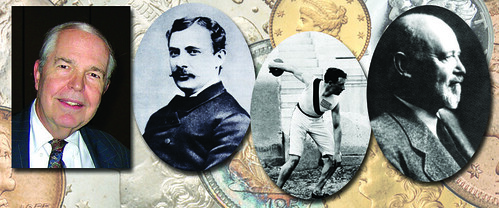
PREV ARTICLE
NEXT ARTICLE
FULL ISSUE
PREV FULL ISSUE
T. HARRISON GARRETT AND EVERGREEN HOUSEIn his February 16, 2017 Stack's Bowers blog article, Dave Bowers writes a fascinating account of T. Harrison Garrett and the Evergreen Museum & Library. -Editor
 Our catalog of the D. Brent Pogue Sale Part V is now in distribution. To view the catalog online, visit stacksbowers.com. To order a printed copy, contact our offices at 800-458-4646. As our sale on the evening of March 31 will be held at the Evergreen Museum & Library in Baltimore, it may be interesting to learn about T. Harrison Garrett, who lived and formed his collection there. Later, one of his sons, Ambassador John Work Garrett, also a numismatist par excellence, called it his home as well. Thomas Harrison Garrett began his collecting interest as a student at Princeton in the 1860s, with a New Jersey copper being among his first acquisitions. Born into the wealthy family that controlled the Baltimore & Ohio Railroad, he eagerly collected books, autographs, prints, and other items, keeping and enjoying them at Evergreen House on North Charles Street in Baltimore. In the 1880s he was especially active in numismatic circles, with Baltimore dentist and rare coin dealer Dr. George Massamore representing him at sales under various pseudonyms including "Hotchkiss," "South," and "Harrison." Similarly, many other collectors, particularly advanced ones, kept knowledge of their holdings and their needs a secret, thus hoping to acquire desired pieces at lower prices. In 1885, Garrett's collection, which by that time had an 1804 dollar and the unique hallmark-on-breast 1787 Brasher doubloon, was considered to be second in importance only to that of Lorin G. Parmelee. In actuality, Garrett's collection was much broader and included world and ancient coins as well as tokens and medals, while Parmelee mainly concentrated on obtaining one of each date (but not mintmark varieties) of federal coinage. Parmelee delighted in telling everyone about his collection, which gave it deserved fame. In the same year Garrett acquired en bloc the James L. Claghorn collection of over 30,000 prints, paying the then remarkable figure of $150,000 for it. On Friday morning, June 8, 1888, Garrett and a party of friends, including prominent business leaders, boarded his yacht, Gleam, for a pleasant all-day cruise on Chesapeake Bay. In time the boat docked at the Naval Academy in Annapolis where the men watched the maneuvers of the cadets. Early in the evening they reboarded the Gleam and steamed toward Baltimore. A strong wind made the water too choppy to be on deck, so the travelers stayed in the cabin. All of a sudden they were startled by two loud blasts from the horn of a large steamer. Garrett ran down the companionway and onto the deck at the moment that the steamboat Joppa crashed into its side. The others rushed on deck and were rescued. Garrett was nowhere to be seen. At ten the next morning a banking house owned by the Garrett family was draped in crepe. Garrett's body was never found. In time, his widow gave the coin collection to Robert Garrett, who kept it in his downtown office in Baltimore. In the 1896 Olympic Games, the first in modern times, Robert was a medalist for the United States. Early in the 20th century he sent most of the collection to Princeton, his alma mater, to be displayed. This proved to be a brilliant move, for in 1904 a huge fire ravaged downtown Baltimore, and most of the office was destroyed. Some medals were melted entirely, and some partially. Robert added to the collection casually through Henry Chapman, who kept it up to date with new issues, such as the Saint-Gaudens coins of 1907. In 1919 Robert transferred the coins to his brother, Ambassador John Work Garrett, who moved it back into Evergreen House, in a special area below the library floor. John was an enthusiastic collector and added many important coins, including rarities. In 1942 the Evergreen House and contents were given to the Johns Hopkins University under terms of John's will. The rest is numismatic history! To read the complete article, see: Wayne Homren, Editor The Numismatic Bibliomania Society is a non-profit organization promoting numismatic literature. See our web site at coinbooks.org. To submit items for publication in The E-Sylum, write to the Editor at this address: whomren@gmail.com To subscribe go to: https://my.binhost.com/lists/listinfo/esylum All Rights Reserved. NBS Home Page Contact the NBS webmaster 
|